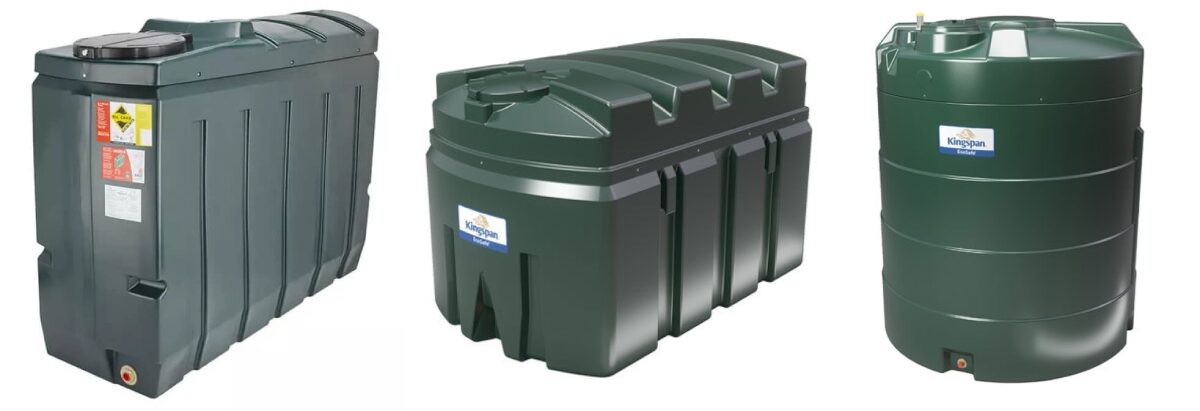
Heating oil tanks typically last around 20 years, however, the older they are, the more likely it is that problems will occur.
Whether you’ve just moved into a new home with a heating oil tank or your oil tank is old and damaged, it’s important to know when your tank needs to be replaced.
In this guide, we’ll consider when it is time to replace your oil tank, the signs to look out for, the cost of replacing an oil tank, and more.
When is it time to replace my oil tank?
If your oil tank causes a leak or spill, it can be incredibly costly to clear up, totaling up to £30,000. So it’s important to keep an eye on the condition of your tank and replace it when necessary.
Oil tanks are designed to last at least 10 years, but they often last up to 20 if they are kept well maintained. If your domestic heating oil tank is approaching its tenth birthday or there are signs of damage, you may need a replacement.
You should arrange an annual inspection of your oil tank by an OFTEC Registered Technician, who will be able to tell you if your tank needs replacing. You may also notice signs that it could be time to replace your oil tank.
Our delivery drivers will always give the tank a visual inspection before depositing the fuels into the tank. They will make you aware of any noticeable signs that the integrity of the tank is a concern but may also refuse to deliver fuel if they feel that the tank is no longer fit for purpose or presents a risk of splitting when full.
What should I look out for?
When inspecting your oil tank, look out for the following signs that it could be time to replace your oil tank:
- Oil leaks
- Condensation
- Signs of damage
- Signs of corrosion
- Plastic swelling
- Increased fuel usage
- Bulging
Should I choose the same tank again?
In some cases, you will be able to replace your oil tank with one that is like-for-like. However, it’s important to be aware that rules and regulations may have changed since your old oil tank was installed.
Bunded oil tanks are often required today to meet the latest regulations. So, if your old tank is single-skin, you may need to replace it with a bunded tank, consisting of a tank within a tank to help protect against spillages and environmental damage.
Fire protection requirements may also have changed since your current oil tank was installed. Part of the Building Regulations and Standards helps protect oil tanks from a fire at a neighbouring property or structure. Oil tanks now have to meet minimum clearance distances, which may mean that you need to re-site the tank.
How do I make sure my old tank is safe to remove?
It’s important that your tank is removed safely, which is why it should always be done by a professional, certified engineer.
They will check the tank carefully and measure and test the oil to see how much oil is in the tank, and how much is contaminated at the bottom of the tank. They will then pump the oil out of the tank into a holding tank. Any contaminated, waste oil will then be properly disposed of with a waste oil licence.
Once the oil has been disposed of, the tank can be disconnected, cleaned, and then taken to an appropriate recycling centre.
How are oil tanks replaced?
The process of replacing an oil tank depends on a number of factors, including the type and condition of the old tank. However, it usually includes the following steps:
Assessment of old tank
The heating engineer will assess the condition of your old heating tank.
Transfer of oil
If there is any oil remaining in your old tank, it will need to be removed. Any clean, useable oil will be pumped into a holding vessel, while any water and contaminated oil will be removed and disposed of.
Removal of the old tank
The old tank will be removed and recycled.
New tank installation
Once the old tank has been removed, the new tank will be installed. Any necessary adjustments will be made to the base before the new tank is moved into position, connected to the oil supply line, and secured.
Oil transfer
Any clean, reusable oil that was retrieved from the old tank will be pumped into the new one.
Installation check
The engineer will carry out a comprehensive check of the installation including everything is safe and working.
How much will it cost to replace it?
The cost of replacing an oil tank depends on a number of factors, including the type and size of the oil tank you choose, and the cost of installation. New oil tanks typically start from £1,000, while installation costs can be up to an additional £1,000.
It’s also important to remember that any oil left in your tank will need to be drained before the tank is replaced. This can add around £350 to the cost of replacement.
Get a replacement quote today!
What are the regulations on replacing my oil tank?
Anyone who uses oil for their heating has a legal responsibility for maintaining their oil tank.
There is no requirement to replace an oil tank. However, it is against the law to cause pollution and you can face significant fines if you fail to prevent an oil spill, so it’s important you regularly check for signs that your tank may need to be replaced and act accordingly.
The tank
When choosing a new oil tank, it’s important to ensure that it meets the minimum standards laid out by building control regulations.
The location
When replacing your oil tank, you must also check that the location meets the latest regulations in terms of positioning, including:
- The tank must be at least 760mm from a boundary
- If you’re screening your new tank, the screen must be at least 600mm from the tank
- It must be 1.8m from non-fire rated buildings and structures, openings such as doors and windows, and the oil boiler’s flue terminal
- It must be 50 metres away from a spring, well, or borehole, and 10 metres away from a water course such as a river, stream, pond, or drain
- The tank must not be located anywhere spilt oil could enter drains or manholes, or pollute groundwater
- It must not be located anywhere at risk of flooding
The installer
The person installing your oil tank must be OFTEC registered or registered with another relevant scheme. If your tank is replaced by someone who is not registered by OFTEC or another industry body, you must inform building control so that the work can be inspected before being signed off.
In addition to this, if you live on a listed property, you will need planning permission for the new oil tank. If you live in a non-listed property, you may still need planning permission, depending on the height and proposed location of the new tank.
Do I need to fill in any forms/documents?
Providing you use a registered installer, they will handle all of the paperwork and documentation on your behalf. They are permitted to self-certify that their work complies with building regulations.
If your installer isn’t registered with a competent person scheme such as OFTEC, you will need to apply for a Building Control Notice and arrange for an inspection yourself.
With over 40 years of experience delivering oil for household and commercial use, we are one of the country’s leading distributors. Explore our range of bunded oil tanks here and get in touch to find out more about replacing your heating oil tank.
Why Choose Us?
Our comprehensive guide provides expert tips and step-by-step instructions to ensure a smooth transition. Learn how to choose the perfect tank size, select the right material for longevity, and navigate the installation process like a pro.
Our team of industry veterans shares invaluable insights and precautions to avoid costly mistakes. Gain peace of mind knowing you’re investing in a reliable, energy-efficient, and environmentally friendly heating system.
Contact our team by calling 01829 700120 and get a free quote here today.


